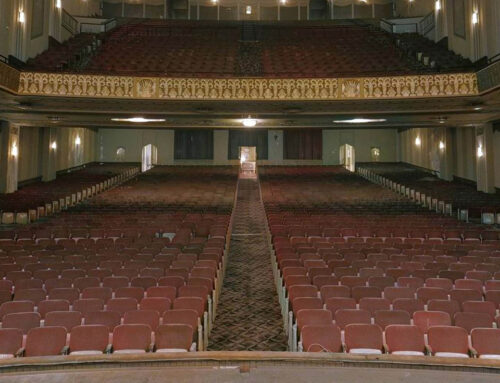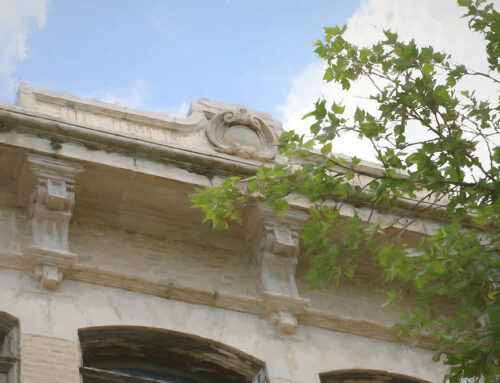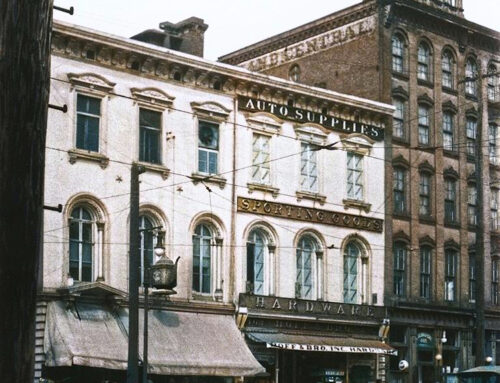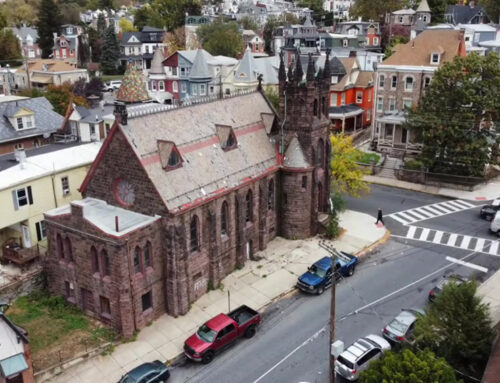Rising 19 stories or 275 ft., the county courthouse is the tallest building in Reading. The courthouse, located at the northeast corner of Sixth and Court Streets, was the only skyscraper and art-deco style temple of justice in the United States when it was completed in 1932, and is one of three art deco buildings in the city. The others are the Medical Arts Building, 421 N. Fifth St., and Northwest Middle School.

The courthouse was designed by Miles B. Dechant, Reading engineer, architect and artist, and was constructed at a cost of about $2 million.
The building’s facade is chiseled into sharp angles and vertical indentations common to art deco. The stepped silhouette creates a striking appearance to the city’s skyline.
Stone, wood, and metal from foreign countries went into the massive, ornamental structure. Three million bricks were used. The outside walls are granite and Indiana limestone.
The courthouse is featured in a book called “Courthouse.” It’s a pictorial account of courthouses throughout the United States. The Berks County courthouse occupies the largest amount of space in the book.
To construct the new courthouse the old courthouse, built in 1840 in the style of the Greek revival tradition, had to be removed. This was met with bitter opposition by many. Insistent demands were made that something be done to preserve the structure in the way of a memorial hall.
For a time it appeared as though some shrine would be developed with the front but upon orders of the county commissioners, every stone in the foundation and columns were removed.
In February, 1931, a temporary courthouse was setup in the old Nogar building at the corner of 4th and Court Streets.
The Goddess of Liberty, which stood on top of the old Courthouse from 1840, was removed from her lofty perch atop the old courthouse and loaded onto a truck .
She was to go on the lawn of the Historical Society of Berks County at Centre Avenue and Spring Street.
But after a few days she was considered “an ugly piece of art” and her tarnished sides were declared anything but an attraction. Anyone could have it for the taking.
But there were no takers. The Goddess was taken to a dump in Glenside, where she gazed rather mournfully over the banks of the Schuylkill River and a public dumping ground.
Later, Dominic Mauer, who obtained the demolition rights to the former courthouse, took pity on the Goddess, loaded her on his truck and set out for the Oley Valley. There at his home below Stonersville he placed her on a pedestal overlooking Boyertown Pike.
Eventually, the goddess made her way to the services center in celebration of the county’s 250th anniversary in 2002. A group of union workers carried her from City Hall to the lobby one Saturday morning.

CONSTRUCTION BEGINS
Demolition of the old the old courthouse which occupied the site started on May 4, 1931.
On June 6, 1931, the first of the deep excavations at the site of the new courthouse were made. Digging continued until August 11. Concrete foundations were first laid on August 7, and on August 12 the structural steel workers began their job. On September 5 the concrete foundations were completed, and the structural steel work was done by October 16.
The next step, the structural concrete, was begun on September 3 and continued until November 5. Two days before this job was finished the limestone and brick work was started, and lasted until February of 1932. Then followed the various other jobs in the general contract and the installation projects such as heating, plumbing, electrical work and furnishings. Except for the furnishings the skyscraper was substantially complete by August 15, 1932.
Below: Berks County Courthouse Construction.


DEDICATION CEREMONY
Berks County’s new courthouse was formally opened and dedicated on December 2, 1932.
Jurists and distinguished barristers came from the four corners of the State to assist at the opening, to lavish high praise upon the bench and bar, and to tell judges and county officials that the new 19-story, $2,000,000 building was “magnificent.”
“Let this wonderful structure bespeak more of what is to come from within than what is to be seen from without,” Justice John W. Kephart of the Pennsylvania Supreme Court bench, told the several hundred persons who squeezed into the Colonial main court room on the firth floor to hear the simple opening ceremony.
“Your handsome new court house gives new dignity and impressiveness to the administration of the law,” Frank M. Trexler, president judge of the Pennsylvania superior court, declared.
Long before the brief ceremonies got under way, visitors from Berks, and neighboring counties were flocking through the building and standing outside the main court room doors in the hope of getting one of the 100 odd unreserved seats. When the exercises, which were held as a regular session of court at the request of Justice Kephart got under way a few minutes after 10:30 AM, the main floor and balcony were filled to overflowing with judges and lawyers from other counties, members of the Berks bar, county officials, and guests of Judges, lawyers and office holders.
John Mast, white-haired and venerable court crier who had opened court sessions in Berks County for over 30 years, opened the session. First he announced those who would sit on the rostrum, in the high-backed, scarlet-leather Judges’ chairs. And then the time-worn chant . . . “Oyez, Oyez, Oyez . . . God save the Commonwealth and this Honorable Court!”
Judge Marx was master of ceremonies, and introduced first Judge Schaeffer, who from his chair read an historical paper dealing with the long and brilliant history of the administration of the law in the county of the Penn’s.
In brief and gracious introductory remarks, Judge Marx told of the need for a new county building. “After repeated recommendations by grand juries, the rebuilding was started,” Marx said. “Today we behold the consummation of our dreams.”
ARCHITECTURAL FEATURES OF COURT HOUSE
ELEVATORS
The elevator cabs of the courthouse were built exactly to the specifications for those in the skyscraping Empire State building in New York, and are similar in all but one detail. Those at the court house were only half as fast, the same speed not being required. Doors of the elevators on the ground floor are made of hammered bronze, in two hues.

Below: Main Corridor Vaulted Ceiling.

Below: Main Lobby Globe.

TREASURER’S OFFICE
On the first floor is the former county treasurer’s office. The office is done in green and rose. Marble is used profusely, with the vert maurin variety, a subdued green, used chiefly, and tavernelle, a rose-colored marble, for trim. Writing counters are made of these two hues of marble, too, and the counters used by the offices staffs.
Below: Writing Counter in former Treasurer’s Office, 1st Floor.

COURTROOMS
Courtroom 5A, the main courtroom, is the largest and most impressive room in the entire building. Designed in Colonial style of the 1740’s, it has dignity, stateliness, and a chaste beauty. Courtroom 5A is the only courtroom in the County courthouse that has a balcony. The windows are deep-set, as those of old colonial buildings, and wood-paneled their whole depth. The upholstery of the courtroom furniture – high judges’ chairs, lawyers’ chairs, jury seats – is of scarlet leather. The chandeliers are about three feet in diameter. They are hung upon ornamental brass fasces, symbols of authority since the days of the Roman Empire. The room is trimmed in white-and-black marble, called French grand antique. The spectators’ benches are of walnut, as are the rest of the upholstered furnishings.
Below: Courtroom 5A, Fifth Floor.

Courtroom 5B, on the same floor, is much like courtroom 5A except its Colonial design is of a later period, Federal, along toward the end of the eighteenth century.
Below: Courtroom 5B, Fifth Floor.

Court room 7A and its sister courtroom 7B are substantially identical in both size and layout. They are categorized by the interesting and intricate corbels which surround the room. Done in the Italian Renaissance style, their chief characteristic is the painted background of the benches, done in various colors. All the fixtures and walls in courtroom 7A are made of a light colored marble. In courtroom 7B the fixtures and walls are same features are sculpted in walnut.
Below: Courtroom 7A, Seventh Floor.

Below: Courtroom 7B, Seventh Floor.

Court room 9 on the ninth floor is in the modem style, with blue and silver the dominant colors. Furniture is of walnut, squarely cut as though carved from solid blocks of wood.
Below: Ninth Floor Courtroom.

LAW LIBRARY
The law library is open to the public and is located on the tenth floor. It has Corinthian columns, and a balcony for the book stacks.
WEATHER BUREAU
The weather bureau was originally located on the eighteenth floor. Today it is used as the 911 backup call center.
FIRST COURTHOUSE
This first official courthouse of Berks County was in the middle of Penn Square at 5th and Penn Streets. The court house was built of stone, plastered and marked off in imitation of cut stone, and was surrounded by a brick pavement about 13 feet wide. The building was about 40 by 50 feet in size. The front door to the Court House faced south.
Below: Market Square, a.k.a. Penn Square, 5th and Penn Streets, looking north. To the right of the Court House is the White Store, which evolved into Joseph L. Stichter’s hardware store. Behind it is Trinity Lutheran Church’s steeple. At far right is a portion of East Penn Square’s market stall, removed in 1871. The rendering is by F. A. Holtzwart, an artist who came to Reading in the 1830s.

The first floor was arranged in one large room for the “courts,” and the second floor into three rooms, the eastern half in one room and the western half in two rooms. An entry separated the two sections.
The stairway was constructed in the southeast corner of the court room. The “bench” was arranged along the northern side of the room, and the “bar” was enclosed by a semicircular railing, the ends of which extended to the wall on both sides of the “bench.” The Jury box was situated in the northwest corner of the room.
The court room was entered by two doorways, one on the south side and the other on the west. The latter was little used. A large stove was located nearby, and wood was generally piled up against the door, inside, during cold weather.
The crier’s seat was located a few feet west of the center of the room, adjoining the “bar,” and the prisoners’ dock was next to it on the east. The crier was a prominent figure in the room, by reason of the elevation of his seat.
The floor was laid with brick. Benches were arranged on inclined platforms along the southern and eastern walls. The seating capacity was rather limited for a public place. A marble tablet was built in the eastern wall near the center, which contained the following inscription, “J. L., C. W., S. H., 1762.” These initial letters represented the names of the officiating county commissioners, Jacob Lighfoot, Christopher Whitman and Samuel High.
The steeple contained a bell and town clock. The bell was cast in England in 1763, especially for this country, and the clock was a 30-hour clock, imported from London about 1755.
This building was used for the purpose of hearing criminal and civil cases until 1840, the last term of court there being the April term in that year. During the following three months the county records were transferred from the building then used for county offices, the “State House,” to the new court house which had been completed that year. The old court house was sold to Joseph Kendall at public sale, and he removed it in May, 1841.
In addition to the first court house at Fifth and Penn streets, there was erected on the northeast corner of that intersection in 1793 the “State House,” for the accommodation of the county offices and the public records. It was built of brick, and was 30 by 80 feet in dimensions, with a narrow alley extending along the eastern wall from the front to the rear.
An entry extended across the building near the center, with its doorway on Fifth street, and a stairway led from this entry to the second floor. The first floor was divided into three compartments, the first, adjoining Penn street for the use of the prothonotary’s office and clerk of quarter sessions, the central one for the recorder, register and clerk of the orphans’ court, and the rear one for county commissioners and county treasurer.
Previous to the erection of this first court house, for a period of 10 years, Judges of the courts held their sessions in an inn in the town. There were no rooms in the building for the county officials but many were not necessary, for five offices were vested in one individual for upwards of 20 years, these having been the prothonotary, recorder, register, clerk of orphans’ court and clerk of the quarter sessions and the man who held these joint offices was James Read, a lawyer.
In the 1970’s, workmen dug down about five feet into the street, at the Court House site, and unearthed its brick floor, which was surprisingly intact Around 1888, Penn Square was extensively graded, which explains the change in surface elevation.
SECOND COURTHOUSE

Smallness of the first courthouse at the center of Fifth and Penn Streets had been felt for many years, and the increasing inconvenience had become so objectionable by the year 1837 that taxpayers and officials determined to remedy the situation by securing a new building.
To that end a petition was presented to the judges at the August session, setting forth “that, in consequence of the rapid increase of the population and public business of the county of Berks, the present court house has become too small and inconvenient for the transaction of business, and also for the accommodation of those persons who are obliged to attend court,” and praying the court “to recommend to the county commissioners the erection of the necessary buildings for the accommodation of the court and the public.”
This petition was referred to the grand Jury which recommended a new building, selecting the northeast corner of Fifth and Penn streets as the site for it. This return was approved by the court on August 11, 1837, but the site was changed to the northeast corner of Sixth and Court streets, in order to obtain a larger lot for the proposed building.
The county commissioners then purchased at that corner two adjoining lots, 120 by 230 in size, and during the years from 1838 to 1840 erected on the site the western half, or front, of the court house that served the county until 1930. Dimensions of this section were 62 feet wide and 118 feet long, it being three stories high. The total cost was $63,000. The courthouse was designed by Thomas Walter who also designed the US Capitol dome.
In 1869 a fireproof two-story addition was added in the rear, and this was subsequently enlarged, with numerous improvements made to the building.
The first session of court was held at the new court house in August term, 1840.
Gas was introduced into the new building for lighting purposes in May, 1849, shortly after the Reading Gas company established its plant. Previously oil lamps were used.
In October, 1851, a new clock, with a bell, weighing nearly 1,700 pounds, was placed in the steeple of the court house, and from that time on this was the “town clock” and town bell for indicating “town time.” The clock dials were first illuminated at night time by electricity in 1895.
Additional Facts:
- The first unofficial courthouse would have been a tavern which was the case in many courthouses in early America.
- Miles B. Dechant, designer of the courthouse, also designed the City Park Band Shell.
- The hardware for the courthouse was supplied by the Penn Hardware Company. The Penn Hardware company equipped numerous other buildings in Reading, including the the Museum and Art Gallery, Metropolitan Edison building, the Berkshire Hotel, the Charles Muhlenberg, Jr., residence, the Reading Company Y. M. C. A., and the Embassy theatre. The company was established in 1877.
- The courthouse was equipped with 52 flood lights on the eighteenth and nineteenth to illuminate the tower of the courthouse nightly with a white glow. During the Christmas season the clear lights were replaced with red and green color lights to emphasize the Christmas spirit.

- In 1964 the red and green lights which illuminated the top of the Berks County courthouse for about a decade were replaced with blue and red “weather” lights marking an end to flashing red and green lights which in the past had been a Christmas landmark. But the usual cross was still illuminated. The cross effect was achieved by placing spot lights behind certain windows in the courthouse. The lights were displayed on the east, south and west sides, Stairways on the north side prevented the cross effect from that vantage point. Of the 104 lights, the bulk of them were placed along the top parapet. Some were located at an offset, one-story lower. The lower lights lit the corners of the top of the courthouse. If the weather changed from stormy to fair, the top of the courthouse was red and the corners blue. If the weather changed from fair to stormy, the top was blue and the corners red. In the 1990s, it was getting tougher to find the right light bulbs, and some of wires were no longer working. A decision was made stop using the courthouse as a weather beacon. The red and blue lights were removed in 1995. The red and blue lights were replaced with amber lights after 1995 giving a yellowish and green appearance against the granite and Indiana limestone facade. The Berks County courthouse is no longer illuminated.






Leave A Comment